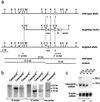Trophoblast cell-specific carcinoembryonic antigen cell adhesion molecule 9 is not required for placental development or a positive outcome of allotypic pregnancies
- PMID: 10982830
- PMCID: PMC86267
- DOI: 10.1128/MCB.20.19.7140-7145.2000
Trophoblast cell-specific carcinoembryonic antigen cell adhesion molecule 9 is not required for placental development or a positive outcome of allotypic pregnancies
Abstract
The carcinoembryonic antigen (CEA) family consists of a large group of evolutionarily divergent glycoproteins. The secreted pregnancy-specific glycoproteins constitute a subgroup within the CEA family. They are predominantly expressed in trophoblast cells throughout placental development and are essential for a positive outcome of pregnancy, possibly by protecting the semiallotypic fetus from the maternal immune system. The murine CEA gene family member CEA cell adhesion molecule 9 (Ceacam9) also exhibits a trophoblast-specific expression pattern. However, its mRNA is found only in certain populations of trophoblast giant cells during early stages of placental development. It is exceptionally well conserved in the rat (over 90% identity on the amino acid level) but is absent from humans. To determine its role during murine development, Ceacam9 was inactivated by homologous recombination. Ceacam9(-/-) mice on both BALB/c and 129/Sv backgrounds developed indistinguishably from heterozygous or wild-type littermates with respect to sex ratio, weight gain, and fertility. Furthermore, the placental morphology and the expression pattern of trophoblast marker genes in the placentae of Ceacam9(-/-) females exhibited no differences. Both backcross analyses and transfer of BALB/c Ceacam9(-/-) blastocysts into pseudopregnant C57BL/6 foster mothers indicated that Ceacam9 is not needed for the protection of the embryo in a semiallogeneic or allogeneic situation. Taken together, Ceacam9 is dispensable for murine placental and embryonic development despite being highly conserved within rodents.
Figures


Similar articles
-
Carcinoembryonic antigen-related cell adhesion molecule 10 expressed specifically early in pregnancy in the decidua is dispensable for normal murine development.Mol Cell Biol. 2003 Jan;23(1):272-9. doi: 10.1128/MCB.23.1.272-279.2003. Mol Cell Biol. 2003. PMID: 12482980 Free PMC article.
-
cea5, a structurally divergent member of the murine carcinoembryonic antigen gene family, is exclusively expressed during early placental development in trophoblast giant cells.J Biol Chem. 1997 Dec 12;272(50):31369-76. doi: 10.1074/jbc.272.50.31369. J Biol Chem. 1997. PMID: 9395467
-
The immune-modulating pregnancy-specific glycoproteins evolve rapidly and their presence correlates with hemochorial placentation in primates.BMC Genomics. 2021 Feb 18;22(1):128. doi: 10.1186/s12864-021-07413-8. BMC Genomics. 2021. PMID: 33602137 Free PMC article.
-
PPARgamma and early human placental development.Curr Med Chem. 2008;15(28):3011-24. doi: 10.2174/092986708786848677. Curr Med Chem. 2008. PMID: 19075649 Review.
-
Placental bed research: II. Functional and immunological investigations of the placental bed.Am J Obstet Gynecol. 2019 Nov;221(5):457-469. doi: 10.1016/j.ajog.2019.07.010. Epub 2019 Jul 6. Am J Obstet Gynecol. 2019. PMID: 31288009 Review.
Cited by
-
Carcinoembryonic antigen-related cell adhesion molecule 10 expressed specifically early in pregnancy in the decidua is dispensable for normal murine development.Mol Cell Biol. 2003 Jan;23(1):272-9. doi: 10.1128/MCB.23.1.272-279.2003. Mol Cell Biol. 2003. PMID: 12482980 Free PMC article.
-
Widespread divergence of the CEACAM/PSG genes in vertebrates and humans suggests sensitivity to selection.PLoS One. 2013 Apr 16;8(4):e61701. doi: 10.1371/journal.pone.0061701. Print 2013. PLoS One. 2013. PMID: 23613906 Free PMC article.
References
-
- Beauchemin N, Draber P, Dveksler G, Gold P, Gray-Owen S, Grunert F, Hammarström S, Holmes K V, Karlson A, Kuroki M, Lin S H, Lucka L, Najjar S M, Neumaier M, Öbrink B, Shively J E, Skubitz K M, Stanners C P, Thomas P, Thompson J A, Virji M, von Kleist S, Wagener C, Watt S, Zimmermann W. Redefined nomenclature for members of the carcinoembryonic antigen family. Exp Cell Res. 1999;252:243–249. - PubMed
-
- Bohn H, Weinmann E. [Immunological disruption of implantation in monkeys with antibodies to human pregnancy specific beta 1-glycoprotein (SP1) (author's translation).] Arch. Gynakol. 1974;217:209–218. . (In German.) - PubMed
-
- Colosi P, Talamantes F, Linzer D I. Molecular cloning and expression of mouse placental lactogen I complementary deoxyribonucleic acid. Mol Endocrinol. 1987;1:767–776. - PubMed
Publication types
MeSH terms
Substances
LinkOut - more resources
Full Text Sources
Molecular Biology Databases
